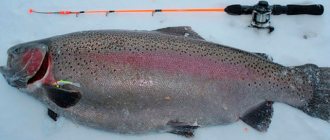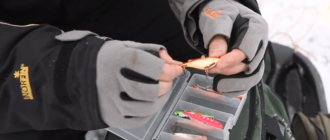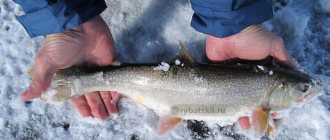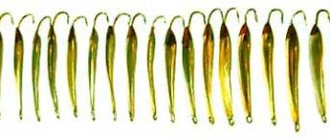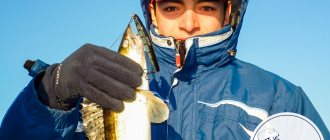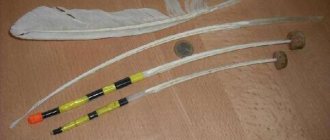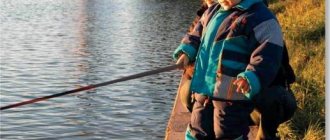Where and when to fish
Trout lives in fresh water and loves clean and very cold rivers. Most often it lives in mountain lakes. There are two types of predator: lake and stream. The fish is highly attentive and cautious, which is why it is quite difficult to catch. There are paid reservoirs for catching trout. At the same time, there are places where it is bred.
At the end of winter, when the ice melts, trout become active.
This fish loves rivers with large currents. This is because in the daytime, when trout are not hunting, they go to the bottom, stand against the current, and begin to catch fry swimming with the flow. She prefers rocky bottoms.
Where to catch trout
We looked at fishermen's reports and marked on the map where trout were found.
Reservoirs
When fishing for trout, there are three main types of conditions in which fishing is carried out:
- Lakes, ponds and other stagnant bodies of water.
- Streams.
- Stormy rivers.
Depending on the conditions of the reservoir, you can select gear, lures and bait, since the principle of fishing in them will be significantly different. Different depths and strengths of the current require the use of different gear, baits and fishing techniques.
Non-flowing
You can catch trout in a lake or pond using any of the existing gear, however, at great depths of the reservoir and during periods when the fish tries to stay in holes and pools, the use of fly fishing, in most cases, is not justified, just like fishing with poppers. In lakes, a float rod, as well as a spinning rod, performs well, since these tackles allow you to fish even quite hard-to-reach areas.
The choice of fishing location directly depends on time and weather conditions. In spring, the most important time to search for trout is in the area of wintering pits, while in autumn it can be found throughout the reservoir.
Streams
Fishing in streams, on the contrary, is ideal for the use of fly fishing flies - prey moving along the surface, resembling an insect, is visible even to fish standing at the very bottom, due to the shallow depth. This minimizes the likelihood of getting caught on a rocky bottom. When fishing for trout in streams, it is important not to get too close to the water so as not to spook the cautious fish, and also to move only against the current. The fact is that the frightened fish goes downstream, falling into holes in which other trout gather, and with its behavior making the latter wary. Accordingly, moving with the flow, you can spoil the bite for yourself.
It is best to look for trout in streams under overhanging tree crowns, in holes in the current, in which a predator usually waits for its prey, as well as near washed-out banks. Another favorite place for trout is the oxygen-rich riffles.
Equipment for trout fishing on donka
One of the important parts of the design is the leash. Its optimal length is about a meter. The diameter of the fishing line is 0.15 millimeters.
Trout tackle must be floating. If the weight of the bait is too heavy, use foam balls. Take care of spare balls, as fish often knock them off when biting. Instead of foam plastic, floating plasticine is also used. It hardens well in cold water, so it becomes impossible to knock it off. The design should be as durable as possible, since sharp hooks are possible when fishing for trout.
Any fishing line is suitable except braided one, since braided line does not stretch well and is not suitable for sharp hooking. Take a sinker weighing 40-50 grams. The optimal shape is a circle or oval.
Any hooks will do. The main thing is that they are quite sharp.
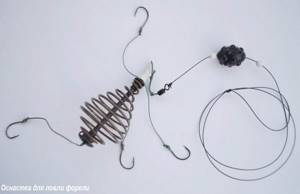
Fishermen are constantly coming up with new designs for trout fishing. You can buy a ready-made design at a fishing store and remake it at your discretion.
Choosing a rod for trout fishing
Fishing will mainly be carried out from the shore; Bolognese, fly or classic float rods up to 7 meters long can be used. The main requirement that must be taken into account when choosing gear is weight. The convenience of the fishing process will largely depend on this parameter.
An excellent solution would be to buy a carbon fiber or composite fishing rod; such options are distinguished by their low weight, but, most importantly, durability and reliability, which is of no small importance when fishing for a caught trophy. Now let’s look at the features of choosing each of the proposed fishing rod options:
• Fly rod. Used when fishing at short distances, rod options are available from 5 to 7 meters in length. It is not necessary to use a reel; the line can be attached directly to the rod tip. The main thing to consider is the weight of the gear, since you will need to hold the fishing rod in your hand throughout the entire fishing process. The choice regarding length is made individually based on the characteristics of the fishing area. So, for example, in cramped conditions you should choose models within 4 meters in length, and in open space you can use a rod 6-7 meters long.
• Bolognese fishing rod. The advantage of the gear is that it can be used to successfully catch trout in bodies of water with standing water and currents. Fishing rods of this type are offered in lengths of 5-8 meters. The blank is equipped with high-quality guide rings, which allows you to install an inertia-free reel. As for the reel, it is recommended to purchase the simplest options, the main thing here is weight, as for the size of the spool, 1,000 is enough. Note that the main purpose of the element is to store a small supply of fishing line (20-25 meters). Using a Bolognese rod will allow you to catch trout using a free floating bait; this fishing technique is especially beneficial during periods of low predator activity.
Read: Where and what you can catch with a float rod in October
• Match fishing rod. Mostly this option is the choice if you plan to fish on lakes with standing water. The tackle allows you to fish at medium distances. The design of the rod includes large guide rings. If you use a spinning reel with a spool size of 1,000, you can successfully catch trout at a distance of 15-20 meters from the fishing point.
Trout fishing with paste equipment
A ball with a diameter of 10 millimeters is made from the paste. The ball is placed on the hook. Hide the point of the hook inside the paste so that the fish does not notice it. Fix the paste on the hook with your fingers so that it does not slip off during the current. You can throw bait into the water. Use a mold to shape the paste as desired. Predators are caught on them more often. These molds are sold in fishing stores.
How to use trout paste
The use of the paste depends on the time of year. It is difficult to use in winter. This takes practice. In winter, trout are picky about their food choices. She becomes cautious and reacts to any noise. Therefore, pay attention to the following:
- In winter, you should rely on baits that have a very strong smell. But the smell should not be strong, so as not to scare away the fish. You should add glitter to the bait, this will attract additional attention.
- Finding trout habitat becomes a big difficulty. The fish does not stand in one place, but constantly moves in search of food. However, it can live only at the bottom or only on the surface of the water.
- If you catch a fish in one hole, move on to the next, as there can only be one fish in one hole.
- If your area has warm winters, use the paste as you would at other times of the year.
The paste should not be frozen so that it does not lose its properties.
The secret of catchy pasta
Trout paste consists of proteins with added flavors. The following flavors work well:
- Garlic.
- Cheese.
- Fish.
- Caviar.
The primaka is cooked depending on whether you want it to touch the bottom or not. Experienced anglers choose the second option, since trout prefer the middle and upper layers of water. If you are fishing in holes, you will need sinking paste. But there is no need to prepare both options. Prepare a sinking paste and attach a piece of foam to the bait. This way she won't drown. If you need the paste to sink, increase the amount of weight.
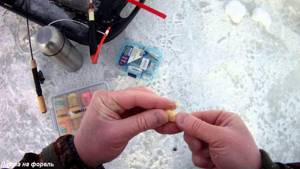
Shine is added to the store-bought paste, which provokes the fish even more. Of the colors, trout respond better to yellow and orange.
Putting pasta on a hook
It is considered difficult to place pasta on a hook. But that's not true. You will need:
- Take a small piece of food.
- Make a ball the size of a corn kernel.
- Place the paste on the hook so that the point and shank are hidden.
- Seal the paste with your fingers so that it does not wash off in the water.
Do not store pasta in the freezer. It loses its smell and beneficial properties.
Don't skimp on pasta. Trout can eat more than half their body weight.
The device of a float trout fishing rod
To catch pied fish, local fishermen use fly rods. They choose a telescopic rod 4–5 m long that is very light, fast action, with a thin and sensitive tip. The main line with a diameter of 0.2 - 0.22 mm is cut to the length of the rod.
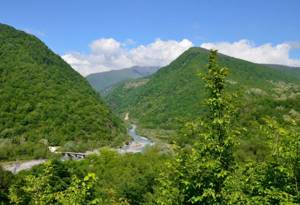
Blind float equipment does not contain anything special, but at the same time it does not allow for special arbitrariness. The float on this tackle is, rather, a bite indicator made from a piece of a match or a small twig attached to the fishing line using a cambric. This indicator is installed at a distance of 0.5 - 1 m from the sinker - depending on the depth at which it is fished.
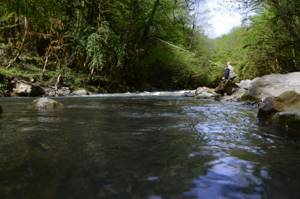
A sliding sinker weighing 2 - 3 g - round or in the form of a thin cylinder. To connect the main fishing line and the leash, a microcarabiner measuring 1.5 - 3 mm is used. A leash with a thickness of 0.15 - 0.17 mm and a length of 20 - 30 cm, preferably fluorocarbon, hook No. 6 - 8 according to the Western European classification.
Lures
Trout is a predator. The bait must be of animal origin. Good fit:
- Fish fry.
- Larvae.
- Worms and maggots.
- Insects.
- Pieces of the trout itself.
- Fresh meat or fish.
- Front sights.
- Wobblers.
- Spoon.
The color and aroma of the bait are important.
The bait must constantly move.
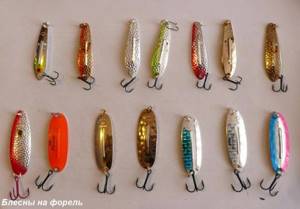
A spoon is suitable as bait. The main thing is that it is mobile enough, this lures a predator. Choose spinners with a length of 50 to 90 millimeters and a thickness of 0.8-1 millimeters.
But the most effective way of fishing is with live bait.
Features of trout fishing on donka
Trout hunting is fun and challenging at the same time. This predatory fish is very attentive; it bites only if the bait is of animal origin.
Donka is one of the best structures for trout fishing. It allows you to fish both on the bottom and while floating. For this type of fish, the second option is suitable, since the predator prefers bait that can move.
First you need to find the trout habitat. She constantly moves in search of food, changing her location.
The best time to catch trout on a donk is the end of autumn, the beginning of winter.
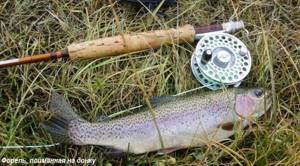
The predator goes out to hunt for food at dawn or dusk. During daylight hours, it hides at the bottom or in snags.
Seasonal features of trout fishing
- In winter, the fish becomes very attentive. Be quiet so as not to scare her away. In severe frosts, she becomes lazy. The digestion process worsens, causing the trout to eat less. It becomes more difficult to catch her. At this time, you need bait with a strong smell.
- For fishing, it is recommended to use a paste with a strong smell and glitter.
- In spring the fish are more active. The best time to catch it is late March - early April.
- In summer the bite is worse. The predator prefers cold water, so it goes to the bottom. It is very difficult to catch trout during the daytime. But at night and in the morning the chances are quite high.
- Autumn is a good time for trout fishing. The mating season begins for the fish. At this time, it lives almost throughout the entire reservoir. Suitable weather conditions are heavy rain or light frost from −1 to −3 degrees. At the end of September, the predator begins to lay eggs. To do this, she looks for shallow places. This is where you should start looking for trout at this time of year.
Elements of equipment for a float rod
Preparing tackle for trout fishing is practically no different from a float rod, which, for example, is planned to catch roach or bream. The only thing worth noting is that equipment for trout should have the minimum possible number of elements and connecting nodes. Now let's look at the main devices that will be required when preparing the gear:
• Coil. To assemble the gear, it is recommended to choose inertia-free models with a front-mounted clutch. The main requirement is light weight. Spool size 1,000-1,500 units. Today, purchasing a reel that will best meet the requirements and is suitable for trout fishing will not be difficult. However, when choosing, you should give preference to models from well-known brands, since their main advantage will be: reliability, impeccable quality and ease of use;
• Fishing line. When fishing for trout, you can use the most common monofilament fishing line with a breaking load of 4-5 kg. Note that a special feature of the fishing line is its ability to stretch as a result of the formation of a load. Experienced fishermen advise using fishing line with a cross-section of 0.18 mm. But this is an option only if the angler has sufficient experience in such fishing. Beginner fishermen are recommended to use a fishing line with a cross-section of 0.2 mm, but in this case it is necessary to use a leash half a meter long with a diameter of 0.15 mm;
• Hooks. When choosing a hook for making equipment, you should first of all be guided by the type and size of the bait that will be used during fishing. Mostly for trout fishing, hooks No. 3-5 with a short shank are used. If you plan to catch trout using paste, then it will be advantageous to use a hook with a special clip, the presence of which will allow the bait to remain on the hook longer after casting. When choosing, special attention must be paid to the quality of the sting, which should be as sharp as possible.
Read: Methods of attaching fishing line to a fly rod
• Floats. The most effective are oval or spherical floats. It is recommended to purchase with neutral color designs. Note that the float, being on the water surface, should not stand out too much. However, if fishing is carried out at a distance of more than 20 meters from the fishing point, then you can opt for models whose antenna will be painted red. Mostly to prepare equipment for trout fishing, floats with a carrying capacity of 1.5-4 grams are used. Today in fishing stores, floats are offered in a large assortment, so there will not be any particular difficulties in choosing them. If desired, you can make a float yourself using the most ordinary goose feather.
